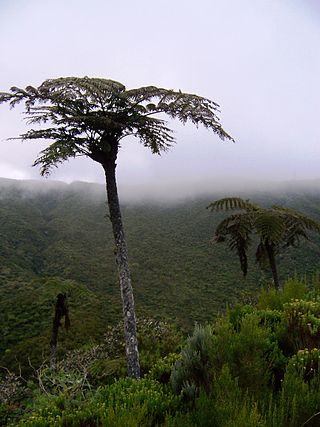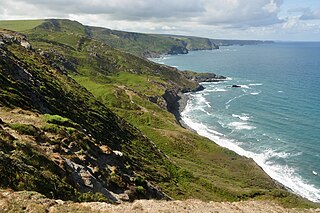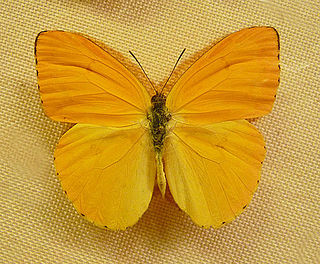
Xylosma is a genus of flowering plants in the family Salicaceae. It contains around 100 species of evergreen shrubs and trees commonly known as brushhollies, xylosmas, or, more ambiguously, "logwoods". The generic name is derived from the Greek words ξύλον (xylon), meaning "wood, tree", and ὀσμή (osmé), meaning "smell", referring to the fragrant wood of some of the species. The Takhtajan system places it in the family Flacourtiaceae, which is considered defunct by the Angiosperm Phylogeny Group.

Argythamnia is a genus of plants of the family Euphorbiaceae first described as a genus in 1756. They are known commonly as silverbushes.

Cyathea is a section in the subgenus Cyathea.

Cyathea is a subgenus in the genus Cyathea.
Xylosma ruiziana is a species of flowering plant in the family Salicaceae. It is endemic to Peru.

Trentepohlia is a genus of filamentous chlorophyte green algae in the family Trentepohliaceae, living free on terrestrial supports such as tree trunks and wet rocks or symbiotically in lichens. The filaments of Trentepohlia have a strong orange colour caused by the presence of large quantities of carotenoid pigments which mask the green of the chlorophyll.

Randia, commonly known as indigoberry, is a mostly Neotropical genus of shrubs or small trees in the Rubiaceae. As of February 2022 Plants of the World Online lists a total of 112 accepted species in the genus. Several Australian species have been reassigned to the genus Atractocarpus. These include the garden plants Atractocarpus chartaceus and A. fitzalanii.

Maranta is a genus of flowering plants in the family Marantaceae, native to tropical Central and South America and the West Indies. Maranta was named for Bartolomeo Maranta, an Italian physician and botanist of the sixteenth century.

Ceunant Llennyrch National Nature Reserve is one of several woodland reserves in the Vale of Ffestiniog in Gwynedd, Wales and runs from Llyn Trawsfynydd to the River Dwyryd, near the village of Maentwrog.
Carbacanthographis is a genus of corticolous (bark-dwelling) lichens in the family Graphidaceae. The genus was circumscribed by German lichenologists Bettina Staiger and Klaus Kalb in 2002. An updated worldwide key to the genus was published in 2022 that added 17 new species.

Prepona laertes, the shaded-blue leafwing or Laertes prepona, is a butterfly of the family Nymphalidae. It is found in large parts of Central and South America.

Dendles Wood is an area of protected oak-beech woodland located on the southern edge of Dartmoor, in the English county of Devon. Forming part of the Dartmoor Special Area of Conservation, the wood is also a Site of Special Scientific Interest, and 30 hectares of it has been designated a national nature reserve. It is one of five woodlands within Dartmoor that have been protected as national nature reserves. Dendles Wood and the adjacent Hawns Wood are sometimes known collectively as Hawns and Dendles. The wood supports a variety of flora and fauna, representative of upland oakwoods. In particular, it has a rich variety of moss and lichen, and several breeding bird species.

Boscastle to Widemouth is a coastal Site of Special Scientific Interest (SSSI) in Cornwall, England, noted for its biological and geological characteristics. The Dizzard dwarf oak woodland is unique and of international importance for its lichen communities, with 131 species recorded.

Phoebis argante, the apricot sulphur or Argante giant sulphur, is a butterfly in the family Pieridae.
Gustavia angustifolia is a small tree, native to South America, with large white flowers. It is an endangered species.

Parides lysander, the Lysander cattleheart, is a species of butterfly in the family Papilionidae. It is found in the Neotropical realm.
Carbacanthographis salazinica is a species of script lichen in the family Graphidaceae. Found in Australia, it was described as a new species in 2001 by lichenologist Alan Archer. The type specimen was collected by Archer in Conglomerate State Forest. Here the lichen was found growing on the bark of a palm tree. Its thallus is thin and grayish-green, with conspicuous white lirellae measuring 1–4 mm long. The specific epithet refers to salazinic acid, the presence of which is a distinguishing characteristic of this species. The lichen also has trace amounts of other secondary chemicals, including consalazinic acid, norstictic acid, and protocetraric acid. In 2005 Archer transferred the taxon to genus Carbacanthographis.

Graphina is a genus of script lichens in the family Graphidaceae. It has about 25 species. The genus was circumscribed in 1880 by Swiss lichenologist Johannes Müller Argoviensis. Müller Argoviensis did not indicate a type species for the genus in his original publication; David Hawksworth proposed to designate Graphina anguina as a lectotype in 1981.













